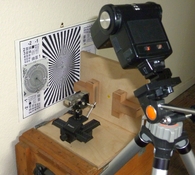I find the most difficult thing in testing lenses on analog cameras is getting the focus 100% spot on, specially on a flat subject.
Henning Serger has a lot of experience in this and I agree with him that it takes many exposures to make sure that you have one with perfect focus.
it also means that we need very high resolution film (ie CMS 20 II) and look at the negative with a microscope or have a very high resolution scanner since otherwise we're measuring the total system resolution rather than lens performance.
with digital cameras it's much easier thanks to the live view zoom. but on the other hand the debayer algorithm comes into play. most modern algorithms will recognise straight pattern and try to improve them over the pure optical image.
all that said, often it's more worth while to test on real images including your preferred workflow. It might well be that for certain light-subject-film-printing combination, a softer lens is more to my taste than the sharpest lens.
for example, when shooting concerts on stage I prefer the rendering of older Nikkors over the more modern Zeiss ZF lenses. the Zeiss are clearly sharper, but I prefer the lower contrast and flare of the older lenses in most cases.
portraits is another case where I sometimes prefer older lenses over the latest sharpest.
Henning Serger has a lot of experience in this and I agree with him that it takes many exposures to make sure that you have one with perfect focus.
it also means that we need very high resolution film (ie CMS 20 II) and look at the negative with a microscope or have a very high resolution scanner since otherwise we're measuring the total system resolution rather than lens performance.
with digital cameras it's much easier thanks to the live view zoom. but on the other hand the debayer algorithm comes into play. most modern algorithms will recognise straight pattern and try to improve them over the pure optical image.
all that said, often it's more worth while to test on real images including your preferred workflow. It might well be that for certain light-subject-film-printing combination, a softer lens is more to my taste than the sharpest lens.
for example, when shooting concerts on stage I prefer the rendering of older Nikkors over the more modern Zeiss ZF lenses. the Zeiss are clearly sharper, but I prefer the lower contrast and flare of the older lenses in most cases.
portraits is another case where I sometimes prefer older lenses over the latest sharpest.




 . Absolutely recommendable to get an impression of the complexity.
. Absolutely recommendable to get an impression of the complexity.



